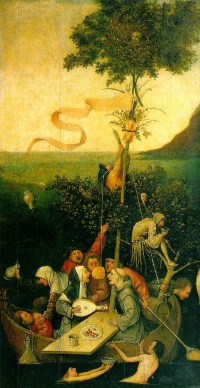Spoudaiogeloion
From The Art and Popular Culture Encyclopedia
(Difference between revisions)
| Revision as of 13:36, 19 July 2013 Jahsonic (Talk | contribs) ← Previous diff |
Current revision Jahsonic (Talk | contribs) |
||
| Line 1: | Line 1: | ||
| + | [[Image:The Experts, 1837 by Alexandre-Gabriel Decamps.jpg |thumb|200px|''[[The Experts]]'' ([[1837]]) by [[Alexandre-Gabriel Decamps]]]] | ||
| + | [[Image:Ship of Fools by Jheronimus Bosch.jpg|thumb|left|200px|This page '''{{PAGENAME}}''' is part of the [[fool|foolishness]] series.<br> | ||
| + | Illustration: ''[[Ship of Fools (painting)|Ship of Fools]]'' by [[Hieronymus Bosch]]]] | ||
| {{Template}} | {{Template}} | ||
| - | '''Spoudaiogeloion''' (Greek: ''σπουδαιογέλοιον'') denotes the mixture of [[serious]] and [[comical]] elements stylistically, from the Greek ''[[spoudaion]]'', "serious", and ''[[geloion]]'', "comical". The combination first appears in [[Aristophanes]]'s ''[[The Frogs]]''. | + | '''Spoudaiogeloion''' (Greek: ''σπουδαιογέλοιον'') denotes the [[mix|mixture]] of [[Seriousness|serious]] and [[Comedy|comical]] elements stylistically. The word comes from the Greek σπουδαῖον ''[[Spoudaios|spoudaion]]'', "serious", and γελοῖον ''[[gelos|geloion]]'', "comical". The combination first appears in [[Aristophanes]]'s ''[[The Frogs]]''. |
| - | [[Plato]] made extensive use of this tone in his ''Gorgias'', ''Euthydemus'', ''Republic'', and ''Laws'', and it is thematic in [[Xenophon]]'s ''Symposium'' and the fourth book of his ''Memorabilia''. | + | [[Plato]] made extensive use of this tone in his ''[[Gorgias (dialogue)|Gorgias]]'', ''[[Euthydemus]]'', ''[[The Republic (Plato)|Republic]]'', and ''[[Laws (dialogue)|Laws]]'', and it is thematic in [[Xenophon]]'s ''[[Symposium (Xenophon)|Symposium]]'' and the fourth book of his ''[[Memorabilia (Xenophon)|Memorabilia]]''. |
| - | The [[serio-comic]] style became a rhetorical mainstay of the [[Cynics]], and the Romans gave it its own genre in the form of [[satire]], contributed to most notably by the poets [[Horace]] and [[Satires of Juvenal|Juvenal]]. | + | The serio-comic style became a rhetorical mainstay of the [[Cynicism (philosophy)|Cynics]], and the Romans gave it its own genre in the form of [[satire]], contributed to most notably by the poets [[Horace]] and [[Satires of Juvenal|Juvenal]]. |
| [[Monimus]], [[Menippus]] and [[Meleager of Gadara]] are held to be practitioners of the genre. | [[Monimus]], [[Menippus]] and [[Meleager of Gadara]] are held to be practitioners of the genre. | ||
| ==See also== | ==See also== | ||
| + | *[[Satire]] | ||
| *[[Serio ludere]] | *[[Serio ludere]] | ||
| + | *[[Tragicomedy ]] | ||
| + | *[[Morosophy]] | ||
| {{GFDL}} | {{GFDL}} | ||
| + | [[Category:Dicta]] | ||
Current revision

This page Spoudaiogeloion is part of the foolishness series.
Illustration: Ship of Fools by Hieronymus Bosch
Illustration: Ship of Fools by Hieronymus Bosch
|
Related e |
|
Featured: |
Spoudaiogeloion (Greek: σπουδαιογέλοιον) denotes the mixture of serious and comical elements stylistically. The word comes from the Greek σπουδαῖον spoudaion, "serious", and γελοῖον geloion, "comical". The combination first appears in Aristophanes's The Frogs.
Plato made extensive use of this tone in his Gorgias, Euthydemus, Republic, and Laws, and it is thematic in Xenophon's Symposium and the fourth book of his Memorabilia.
The serio-comic style became a rhetorical mainstay of the Cynics, and the Romans gave it its own genre in the form of satire, contributed to most notably by the poets Horace and Juvenal.
Monimus, Menippus and Meleager of Gadara are held to be practitioners of the genre.
[edit]
See also
Unless indicated otherwise, the text in this article is either based on Wikipedia article "Spoudaiogeloion" or another language Wikipedia page thereof used under the terms of the GNU Free Documentation License; or on research by Jahsonic and friends. See Art and Popular Culture's copyright notice.


